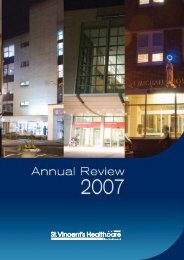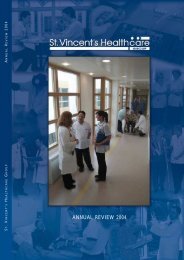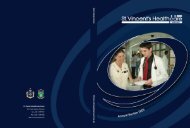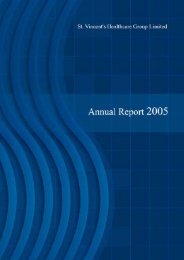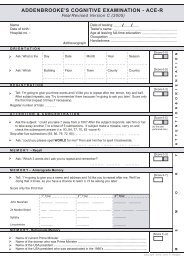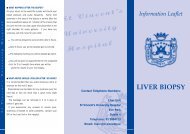The Addenbrooke's Cognitive Examination Revised (ACE-R): a brief ...
The Addenbrooke's Cognitive Examination Revised (ACE-R): a brief ...
The Addenbrooke's Cognitive Examination Revised (ACE-R): a brief ...
Create successful ePaper yourself
Turn your PDF publications into a flip-book with our unique Google optimized e-Paper software.
1084 e. mioshi ET AL.<br />
components (e.g. early repetition trials of the name<br />
and address, reading of regular words and sentence<br />
comprehension) were excluded from the revised<br />
version. Modifications on the naming test were made<br />
to present pictures with lower familiarity than the first<br />
version (Snodgrass and Vanderwart, 1980). <strong>The</strong><br />
expansion of the visuospatial domain might have also<br />
contributed to better sensitivity and specificity.<br />
<strong>The</strong> table of likelihood ratio offers an extra tool for a<br />
clinician when assessing patients with possible<br />
dementia. Table 4 shows that the likelihood of a<br />
given score coming from a ‘case’ rises from 8 to 100<br />
with cut-offs from 88 to 82.<br />
<strong>The</strong> VLOM ratio analyses of the <strong>ACE</strong>-R replicated<br />
the original results very closely (Mathuranath et al.,<br />
2000), which is not surprising since the elements that<br />
contribute to the ratio were changed little in the<br />
revised version. Although some studies have reported<br />
very similar findings (Sarasola et al., 2004; Garcia-<br />
Caballero et al., 2006), others have not supported the<br />
use of the VLOM ratio (Bier et al., 2004; Larner,<br />
2005). This variance is likely to reflect the use of<br />
different criteria across the studies (number of<br />
patients; level of impairment according to the CDR-<br />
R; <strong>ACE</strong>-R cut-off, and FTD criteria). We suggest that<br />
the VLOM ratio does have clinical utility although it<br />
should be noted that the specificity is much better than<br />
the sensitivity.<br />
An important additional facet of the new study is the<br />
availability of cut-off scores for the five sub-domains<br />
of the <strong>ACE</strong>-R. This allows direct comparison of a<br />
subject’s score in a certain domain against normal<br />
controls performance, thus providing more parameters<br />
for a clinical judgement.<br />
Comparison between MCI and controls revealed<br />
interesting findings. Memory impairment was a key<br />
feature, as expected. This finding seems to agree with<br />
evidence that MCI patients have memory testing<br />
performance that place this group in between normal<br />
ageing people and AD patients. (Petersen et al., 1999;<br />
Bozoki et al., 2001; De Jager et al., 2003; Grundman<br />
et al., 2004). In addition, significant impairment<br />
was also found on attention/orientation, fluency and<br />
language tests. <strong>The</strong>se latter findings suggest that the<br />
<strong>ACE</strong>-R is sensitive to mild cases of dementia, such as<br />
MCI patients, and moreover shows a multi-domain<br />
impairment of MCI patients as a group. Follow up of<br />
the MCI group is needed to explore the usefulness of<br />
the <strong>ACE</strong>-R in predicting convertors to dementia, but<br />
experience with the old <strong>ACE</strong> suggests that a cut-off of<br />
80 distinguishes very well between convertors and nonconvertors<br />
(Galton et al., 2005) and that it compares<br />
favourably with standard neuropsychological tests.<br />
KEY POINTS<br />
<strong>The</strong> <strong>ACE</strong>-R is a <strong>brief</strong>, sensitive and specific test<br />
battery to detect early cognitive dysfunction.<br />
<strong>The</strong> VLOM ratio of the <strong>ACE</strong>-R can be used to<br />
differentiate between AD and FTD.<br />
Copies of the <strong>ACE</strong>-R may be requested without<br />
charge from the corresponding author.<br />
<strong>The</strong> <strong>ACE</strong>-R seems to accomplish satisfactory<br />
standards in terms of reliability and validity based<br />
upon standard criteria for evaluating a dementia<br />
screening test (Gifford and Cummings, 1999). We<br />
also assessed common sources of bias that affect<br />
sensitivity and specificity (Gifford and Cummings,<br />
1999). Spectrum bias was avoided by including in<br />
the study patients with different dementia syndromes<br />
and with a broad range of impairment (MMSE<br />
scores ranging from 9 to 30). Blinding of <strong>ACE</strong>-R<br />
administrators from the patients’ CDR scores<br />
prevented review bias.<br />
<strong>The</strong>re are, however, clear limitations. Our patient<br />
group was relatively young, which reflects the bias of<br />
the Cambridge clinics. It is not clear whether these<br />
findings would apply equally to an older patient group.<br />
In addition, our patient group comprised only cortical<br />
dementia diagnosis, which limits the applicability of<br />
these results in patient groups with subcortical<br />
disorders. <strong>The</strong> original version of the <strong>ACE</strong> has,<br />
however, been shown to be sensitive to cognitive<br />
dysfunction found in the atypical parkinsonian<br />
syndromes, e.g. progressive supranuclear palsy and<br />
corticobasal degeneration (Bak et al., 2005).<br />
This study was developed within a university<br />
hospital setting, therefore reflecting a very specialised<br />
population of patients and professionals involved. A<br />
further step should be the evaluation of the <strong>ACE</strong>-R in<br />
community samples, where the prevalence of dementia<br />
is going to differ considerably from a specialised<br />
service. We omitted test-retest reliability because the<br />
study was done in parallel with clinical appointments<br />
or home visits, which meant that setting up this extra<br />
reliability check would limit significantly the number<br />
of patients involved in the study.<br />
Clinical and research settings have similar demands<br />
but typically have very different resources. Research<br />
settings are often better staffed which allows more<br />
time for assessment, whereas clinical ones need<br />
inexpensive, rapid and practical tests, which can be<br />
given without specialist training. Detailed batteries are<br />
Copyright # 2006 John Wiley & Sons, Ltd. Int J Geriatr Psychiatry 2006; 21: 1078–1085.<br />
DOI: 10.1002/gps



